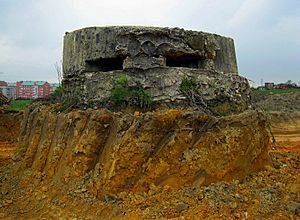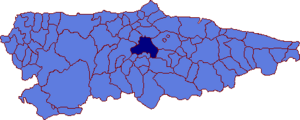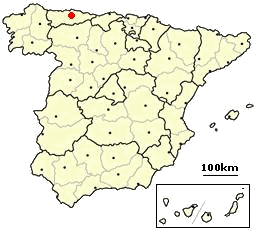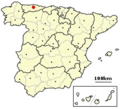Siege of Oviedo facts for kids
Quick facts for kids Siege of Oviedo |
|||||||
|---|---|---|---|---|---|---|---|
| Part of the Spanish Civil War | |||||||
 A bunker at the outskirts of Oviedo |
|||||||
|
|||||||
| Belligerents | |||||||
| Commanders and leaders | |||||||
| Col. Antonio Aranda Col. Eduardo Recas Lt. Col. Carlos Lapresa Rodríguez Lt. Col. Gerardo Caballero (WIA) |
|||||||
| Strength | |||||||
| 10,000 1 light tank 1 armoured tractor |
3,000 3 light tanks |
||||||
| Casualties and losses | |||||||
| 5,000+, 1 light tank | 2,500 | ||||||
The Siege of Oviedo was an important event during the Spanish Civil War. It took place in the city of Oviedo, Spain, from July 19 to October 16, 1936. During this time, a group of soldiers called the Nationalists were surrounded and attacked by Republican forces. The Nationalist soldiers, led by Colonel Antonio Aranda Mata, managed to defend the city until help arrived from other Nationalist troops.
Contents
The Uprising in Oviedo
Oviedo is the capital city of Asturias, a region in Spain. At first, the Nationalists didn't think they could win control of Oviedo. This was because the city had been a center for revolutionary activities. Two years earlier, in 1934, there was a big miners' strike in Asturias. Also, a group called the Popular Front had won elections earlier in 1936.
Colonel Aranda, who was in charge of the soldiers in Oviedo, seemed loyal to the Republic. He even convinced local leaders that everything was calm. Because of this, about 4,000 miners left Oviedo by train to fight elsewhere. But Aranda had a secret plan. He called in police forces, like the Civil Guard, from all over Asturias to gather in Oviedo.
On July 19, Aranda announced that he was joining the Nationalist uprising. The police and other Nationalist groups quickly supported him. Aranda easily took control of Oviedo. However, the rest of Asturias became hostile towards him. Aranda and his forces were now surrounded in Oviedo, cut off from other Nationalist areas.
Aranda's Defense Plan
Colonel Aranda knew he had to hold Oviedo. He had prepared carefully for a long defense. He studied the city's layout and used the military equipment available. He placed over 100 machine guns in five key spots around the city. These spots covered about nine miles.
Oviedo was hard to defend because it was surrounded by hills. But Aranda planned to use these hills to create a "curtain of fire" against attackers. His idea was to defend the city mostly with powerful gunfire.
However, Aranda had a weakness: he only had about 3,000 defenders. This included regular soldiers, police, and volunteers. This meant he couldn't control all the surrounding hills. This gave the attackers an advantage. Luckily for Aranda, the government had stored many guns and a lot of ammunition in Oviedo after the 1934 revolution. He had over a million rounds of ammunition. During a quieter period in August, Aranda even improved his position by launching small attacks. These attacks kept the enemy guessing.
The Siege Begins
The forces attacking Oviedo were mostly militias. These were groups of armed citizens from the Popular Front parties and their allies. They started attacking Oviedo on July 20. At the same time, they were also fighting in another city called Gijón, also in Asturias.
Nationalist forces in Gijón held out until August 16. After Gijón fell on August 21, the Republican militias could focus fully on Oviedo. The fact that a small group of defenders in Gijón had tied up so many attackers for a month was a big win for the Nationalists. It gave them valuable time.
After Gijón, the Popular Front forces tightened their siege around Oviedo. Many of the attackers were miners from Asturias. But they faced several problems. They weren't professional soldiers. Most trained military personnel had joined the Nationalist uprising. Also, a Nationalist relief force was on its way from Galicia. The fighting in Gijón had used up forces that were needed to stop this relief force. The attackers also lacked proper equipment for a siege, except for dynamite. Finally, the terrain around Oviedo made it difficult to attack. Aranda felt confident that the city was well-prepared for defense.
Attackers Tighten the Siege
Two union leaders, Otero and Higinio Carrocera, led the siege. The attackers cut off Oviedo's water supply early on. But the defenders had secured the city's main water reservoir. By carefully using water, they managed to last through the siege. However, they couldn't use water for cleaning. Oviedo was also a storage center for Asturias, so the defenders and people had plenty of food at first.
Not much fighting happened until September 4. Then, the attackers launched a huge bombing and artillery attack. About 1,500 bombs were dropped on Oviedo. This cut off gas, electricity, and phone lines, causing a total blackout. Four days later, the attackers tried to capture a distant outpost. They used an armored steamroller and air support. The defenders fought back by using artillery pieces as anti-aircraft guns. Nationalist troops also had three Trubia A-4 tanks. These were Spanish versions of the French Renault FT tank. After a 12-hour battle, the attackers were pushed back.
The heavy shelling caused many civilian deaths. More people died from diseases like typhoid because there wasn't enough clean water. Some people who had supported the Popular Front even joined the defenders. This happened after their family members were killed or hurt by the attackers' bombs. There was a worry about fighting inside the city between different groups. But these fears disappeared as the attacks got worse and more civilians were hurt. One advantage for the defenders was that many people in Oviedo were politically neutral. On September 10, a bomb from an attacker's plane killed at least 120 civilians, including many children and older people.
The attackers tightened the siege even more in September. Because of the lack of clean water, typhoid spread. This disease caused many deaths, especially among the weak, old, and very young.
The Final Assault Begins
On October 4, the Popular Front militias launched a massive attack on Oviedo. They were in a hurry because strong Nationalist troops from the Army of Africa had joined the relief column from Galicia. This relief column was only 15 miles from Oviedo.
Aranda had lost half of his defenders. The attackers took over one of his defense points, gaining some of the high ground. The Republicans used tanks and armored vehicles. The Nationalists defended the main roads with their three Trubia tanks. One Trubia tank was destroyed by its own crew after it broke down. The attackers also lost many armored vehicles to Nationalist guns and armor-piercing bullets.
The fighting lasted for a week. One by one, the defenders' strong points fell. Aranda pulled his remaining soldiers back into the city. By then, he had used 90% of his ammunition. The defenders ran out of machine gun bullets, and the fighting turned into hand to hand combat. The attackers fought from house to house, cutting holes through walls. Just when the defenders were almost out of ammunition, Nationalist planes managed to drop 30,000 rounds to them.
Aranda's Last Stand
Aranda had only 500 defenders left. He gathered them in the center of the city for a last stand. By this time, the Popular Front militias captured Oviedo's last power plant. The entire city lost electricity. Aranda retreated to the barracks in the middle of the defense. Using a radio powered by a car battery, he told his defenders to "fight like Spaniards to the end." He sent a message to the Nationalist relief column, saying his troops were out of ammunition but would fight until the very end.
The Popular Front militias had also suffered huge losses, with at least 5,000 casualties. They were low on ammunition but were slowly gaining ground. Then, on October 16, just as the defenders faced being completely defeated, the Galician relief column arrived. The Popular Front militias, almost out of ammunition, stopped their attack.
Relief and End of Siege
The Nationalists created a narrow path into the city and held it. Oviedo was no longer in danger. The Popular Front militias left the city and went back to their positions.
Later, from October 25 to 27, there were more battles outside the city. The Nationalists tried to make their path into the city wider. Both sides used armored vehicles and light tanks. In one sweep, a Nationalist Trubia tank captured a broken-down Landesa armed tractor. This tractor had been stuck since September 10. The last big Republican attacks on Oviedo in 1936 happened on November 27, December 1, and December 10. These attacks used armored cars, but little ground was gained.
The final major attack by the Republican army on Oviedo happened on February 21, 1937. A large force of tanks and armored trucks tried to break through the Nationalist lines. The Nationalists used their Trubia A4s and the captured Landesa tractor to defend the city. They were also supported by armored vehicles from the Galician relief column. Nationalist tanks launched a successful counter-attack. The Republican attack was stopped by February 27. The Republicans lost several tanks in these battles. Colonel Aranda continued to serve the Nationalist cause throughout the war.
Images for kids
See also
 In Spanish: Sitio de Oviedo (1936) para niños
In Spanish: Sitio de Oviedo (1936) para niños
- List of Spanish Nationalist military equipment of the Spanish Civil War
- List of Spanish Republican military equipment of the Spanish Civil War





